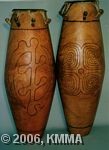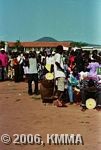


The atsimevu is an open single-headed cylindrical drum that is part of the
traditional Ewe percussion set.
It is the master drum of the percussion ensemble.
The atsimevu drum has a similar shape to the conga, but the drum itself
is played in a completely different way. The atsimevu drum is made of one
single piece of wood or in some cases from strips of wood that are held
together with metal hoops. These drums are almost always painted red, blue or
green. The drum is approximately 130 to 150 cm in height and has a diameter
of 25 cm at the top and 20 cm at the bottom; in the middle the drum widens to
a diameter of 60 cm.
Usually the atsimevu is played solo within an ensemble and is placed in a metal or wooden stand (wudesti) because of its weight and the way it is played. In the stand, the drum is positioned at an angle to open up the sound-hole, which allows the sound to travel better.
The membrane is made of deer or antelope hide and is held in place with loops wound around 8 conical wooden pegs. To tighten the membrane, the wooden pegs are simply hammered in further.
The drummer stands behind the atsimevu and the drum reaches about chest height. There are different ways of playing the atsimevu drum: 1) it is struck with two wooden drumsticks, 2) the membrane is beaten alternately with the palm of the hand and a drumstick, 3) the drum shell (resonator) is struck with a drumstick and the membrane with the palm of the hand.
The membrane can be struck in two places: at the centre with the palm of
the hand and the drumstick or on the outer edge with the fingertips. This
combination allows the drummer to play a low note, a middle note and the high
note. In some cases the drumstick is used to beat against the wood of the
drum.
There are different ways to strike the atsimevu drum:
The atsimevu is decorated with adinkra symbolic figures derived from the kente dress. Commonly-used symbols include:
The atsimevu is highly suited to accompanying dances. It is played by the Ewe as well as by different cultural groups, who use it to widen their range of instruments.
© RMCA/Dominik PHYFFEROEN